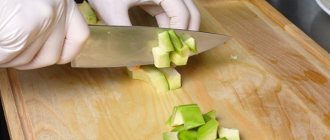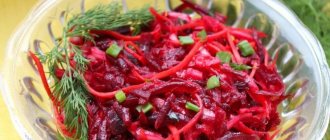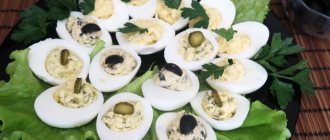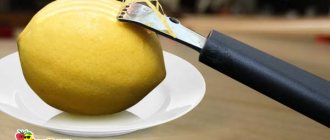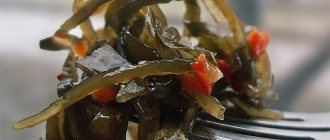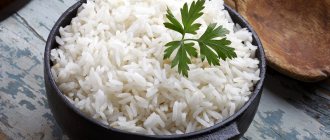How to choose a vegetable
The younger the shoots, the more tender and pleasant they taste.
The tops of the shoots should be elastic, the cut points should not dry out. The asparagus itself should squeak if the stems are gathered into a bunch. When the shoots look limp, without a slight glossy shine, it is better not to take them.
Selecting asparagus plants, like other delicate vegetables, is an art, but it is not difficult to master. You need to choose elastic shoots with smooth tops. The color of the sprouts should be uniform, and the buds on the tops should be unblown. Look carefully at the cut points - if they are dry, you should not buy the vegetable.
The most popular option for cooking green asparagus is boiling it in a tall saucepan. If you have a container for boiling spaghetti, this will be ideal, but any other pan with a height of 30 cm or more will do. You need to pour water into the bottom of such a container and boil the vegetable in it, lowering it cut sides down. This way, the tougher lower part of the shoots will be cooked, while the upper part will be steamed.
Several popular recipes will help you master the preparation of this delicacy. The asparagus family in any form is a source of vitamins and simply a very tasty dish.
What are the benefits of using it?
Asparagus contains the following substances important for the human body:
- vitamins A, C, E - have antioxidant properties;
- B vitamins;
- folic acid - a stimulator of the circulatory and immune systems;
- asparagine - normalizes blood pressure and heart muscle function.
Relatively small quantities also contain vitamin K, potassium, magnesium, iron, selenium, phosphorus, zinc, iodine, choline, which are necessary for bone and connective tissue, the hematopoietic system, and normal functioning of the liver and kidneys.
Hundreds of different dishes are prepared from asparagus - soups and cream soups, puddings, casseroles, pies, quiche, gratin, stews, salads and even desserts. Most ways to cook asparagus involve only short-term heat treatment, which allows you to preserve its beneficial properties.
Boiled asparagus: simple and tasty
Boiled vegetables are an excellent side dish for meat and fish dishes, and can also serve as the basis for lunch. In this case, you need to serve it with the right sauce. Having learned how to cook it correctly, you will be able to delight your loved ones with various dishes based on this.
For cooking you will need:
- 1 bunch of asparagus plant (a bundle of approximately 250-300 grams);
- half a lemon;
- 2 teaspoons salt;
- 1 teaspoon of sugar.
Cut off a couple of centimeters from the end of the shoots and rinse with cold water. Peel with a special knife or very delicately with a potato peeler. You need to peel starting from the middle down, do not clean the tops of the sprouts.
The easiest way to prepare young shoots at home is to boil them in salted water. In addition to salt, you can additionally add a spoonful of honey and a few slices of lemon to the water.
The correct way to boil asparagus is to place the shoots in boiling water and cook in an upright position. To do this, it is best to use a narrow, deep ladle or a special asparagus cooker.
Green stems should be cooked for no more than 8 minutes, and white stems for 10-15 minutes over moderate heat. Frozen asparagus can be cooked in the same way; it does not require pre-defrosting.
You can determine readiness by piercing the stems with a fork - they will be quite soft, but should not fall apart. After draining the water, place the shoots on plates and season with melted butter, adding pine nuts or grated Parmesan - it turns out very tasty!
For the sauce, you can use extra virgin olive oil mixed with balsamic vinegar.
Which asparagus is suitable for cooking?
On store shelves and food market aisles you can find three types of asparagus: bright green, lilac-green with purple scales, and white. When purchasing, you need to pay attention not only to the color of the shoots, but also to their age and freshness.
White is more juicy, tender and sweet in taste. Green, and especially violet-green, have an even brighter taste, and the content of nutrients and vitamins is higher.
Before you cook asparagus, you need to wash and peel it. A special potato peeler is best suited for peeling shoots.
Green and purple shoots are cleaned downward, leaving buds at the top. White asparagus - in the same way, using a knife or potato peeler, peel the entire part of the stem, except the very tips.
Also, before cooking, all types of asparagus must be cut off 1-2 centimeters from the base of the stem (they can be used for cooking lean broth).
From the product history
Traditional Russian cuisine practically does not consider asparagus as a full-fledged vegetable, but the plant is popular among vegetarians, raw foodists and people who are used to counting calories. In Europe, asparagus is especially valued in countries such as:
- Germany;
- Italy;
- France;
- England.
In different areas, preferences are given to different varieties of plants, which differ in color, taste and speed of ripening: the French love white asparagus, the British love green. In total, more than 100 varieties of this crop are known.
The history of the plant goes back to the times of Ancient Egypt, where it was presented as gifts to the goddess of love and fertility, Athena. In Ancient Greece, asparagus stems were used to decorate the newlyweds' beds, which was supposed to attract harmony to the young family.
It was only in Ancient Rome that asparagus was first used not as a medicinal plant or ritual element, but as a vegetable.
Grilled
Tender green shoots baked on the grill are the dish of kings. The main thing is that the cooking process is quick and easy. To grill a vegetable you will need:
- 450 g asparagus plant;
- 2 tbsp. spoons of olive oil;
- 0.5 teaspoons of salt.
Clean the shoots, cut off the lower part by 1-2 cm, rinse with cold water and place on a paper towel. Place on a plate, sprinkle with salt and drizzle with oil. Stir gently.
Place the sprouts on the grill. They should be fried for 4-6 minutes. Turn the sprouts a couple of times during this process. This dish should be served immediately, with grilled meat, fish steaks or seafood.
Green asparagus in a frying pan
There are two types of asparagus: white and green. The difference is that the white one grows underground, it does not see sunlight, so it has this color, its shoots are more tender than the shoots of green asparagus, which reaches towards the sun. But green asparagus is richer in vitamins. Although in fairness it should be noted that both types are very useful. True, white asparagus is not very common in our country. Green is much more common.
This salad can easily replace lunch. After all, in addition to the nutritious asparagus plant, it contains Greek feta cheese and canned tuna fillet.
To prepare this salad, you will need:
- 1 tomato;
- 100 g canned tuna in its own juice;
- 40 g feta cheese;
- 6 shoots of green asparagus;
- 150 g of lettuce to taste;
- 1 tbsp. spoon of olive oil;
- 1 tbsp. spoon of balsamic vinegar
- salt and pepper to taste.
Peel the vegetables and remove tough sections. Cut in half on the bias. Drain the liquid from the canned tuna and shred the fillets with a fork. Tear the lettuce leaves with your hands.
Divide the cheese into pieces with a fork, cut the tomato into small pieces (you can use cherry tomatoes - in this case, cut them in half). Place lettuce, tomato, asparagus plant, tuna and cheese on a plate. Add salt and pepper. Mix olive oil and vinegar and dress the salad with the mixture.
Ingredients
- green asparagus,
- salt and sugar (to taste),
- olive oil and butter (one tablespoon each).
Cooking diagram
- Heat a frying pan, pour in olive oil and add a piece of butter.
- Season with salt and add sugar if desired.
- After the oil in the frying pan has warmed up, carefully place the peeled, washed and towel-dried shoots into the frying pan in one layer.
- Then fry covered, stirring regularly, for 3-5 minutes.
Readiness is checked with a fork; the asparagus should be soft with a golden crispy crust.
Place the finished green asparagus on a paper towel - it will absorb excess fat. Serve as a side dish for meat and fish. This dish will be especially tasty in combination with salmon cooked in a slow cooker or oven.
Green asparagus can serve not only as an independent dish (including vegan and vegetarian) or a side dish for meat/fish, but also serve as an excellent basis for a healthy dietary salad.
Sauce for green asparagus
Having mastered the options for how to prepare sauce for green asparagus, everyone will be able to serve a valuable vegetable with a successful accompaniment and enjoy the new taste of the dish every time.
- Traditional Hollandaise sauce made from yolks, butter and vinegar can be supplemented with mustard for piquancy, or some of the butter can be replaced with cream for less fat.
- An excellent addition would be a mixture of soy sauce, ghee and lemon juice, taken in equal proportions. The resulting gravy can be seasoned to taste with ground pepper mixture and spices to suit your taste.
- An ideal light solution for serving with asparagus is a sauce made from olive oil, lemon juice, minced garlic and dill, seasoned to taste with salt and pepper.
Frozen asparagus with beans
- White beans – 300 g.
- Frozen asparagus – 300 g.
- Onion – 1 pc.
- Garlic – 1-2 cloves.
- Tomato paste – 1 tbsp. l.
- Vegetable oil – 2 tbsp. l.
- Water – 2 l.
- Salt – 2 tsp.
- Spices - to taste.
How to boil and cook asparagus at home
Do not confuse asparagus with the so-called green beans and dry Korean asparagus. The first, although it has some external similarity with green asparagus shoots, belongs to the legume family, and the second is made from soy milk.
However, dried soy “asparagus” (fuju) is very popular in our country, so below we will tell you not only how to cook asparagus shoots, but also give several recipes using fuju.
- 100 g dried soy fuju asparagus,
- 100 g beans,
- 1 juicy carrot,
- bulb,
- a couple of cloves of garlic,
- sunflower oil,
- ground pepper,
- cilantro (or other greens).
How to cook?
- Soak dry asparagus in water for 4-6 hours, cut into thin slices. Boil the beans.
- Chop the onion and carrots and fry in vegetable oil until golden brown.
- Add the boiled beans to the saucepan and after a few minutes add the asparagus, cover with a lid and simmer for 8-10 minutes.
- Turn off the heat, add salt and pepper to the asparagus and vegetables, squeeze out the garlic and add chopped herbs.
- Let stand with the lid closed for a few more minutes.
- Serve the dish in portions, warm.
Contraindications
Since the vegetable remains relatively new in Russian and European cuisine, for the first time it is not recommended to consume it in large quantities. Asparagus is introduced into the diet gradually to avoid irritation of the mucous membranes of the intestines and stomach. People should refrain from eating boiled asparagus:
- with peptic ulcer;
- prone to allergies;
- under two years old.
It is not recommended to use the product in case of acute urinary tract diseases.
Frozen asparagus with beans
- Frozen asparagus – 300-400 g.
- Water – 1 l.
- Salt – 1 tsp.
- Lemon juice – 1 tbsp. l.
- Onion – 1 pc.
- Spices - to taste.
- Vegetable oil – 2 tbsp. l.
- It is not necessary to defrost the asparagus before cooking, but you should rinse it under water to remove excess ice.
- Boil water in a saucepan, add salt and add the greens. Cook for 5-7 minutes.
- Place the asparagus in a colander and let the water drain.
- Chop the onion and fry in a frying pan for 5 minutes.
- Add asparagus and spices to the onion, fry for another 5-7 minutes, then sprinkle everything with lemon juice.
This dish can be eaten hot or cold. It is also suitable as a side dish for meat.
On a note! If the asparagus was harvested late, it may have tougher stems. In this case, increase the cooking time by another 10-15 minutes.
Cooking asparagus is not difficult (like seafood, it is important not to overcook it so as not to lose its color), but tell me how to effectively tell guests a line from the menu: “Friends, today I have prepared for you asparagus with Scottish smoked salmon with ginger sauce.” . It sounds solemn and even slightly defiant. Guests who do not have culinary talents acutely feel their inferiority. And there is little work in the kitchen.
If you manage to get good asparagus, keep in mind: this vegetable goes well with almost all existing products: even with Parma ham, even with tuna, even with curry, even with pears and peaches. It looks very good in salads (for example, with a variety of leafy onions, red onions and peas in a vinaigrette and with freshly ground black pepper, as suggested by idol chef Gordon Ramsay, and he doesn’t recommend anything bad).
But the easiest and most delicious way to deal with asparagus is to simply blanch it (after cutting off the thick stems and leaving just a few centimeters of the delicate top) in boiling salted water for 3-4 minutes. The asparagus will become juicy and tender, and nothing more is required.
You can bake it for a few minutes under grated Parmesan or serve immediately with sauce. The most famous sauce for asparagus is hollandaise (a few yolks, a little lemon juice, a little butter, salt and cayenne pepper). Any creamy or lemony one is good, and even homemade aromatic oil with herbs, slightly melted on asparagus, turns it into a luxury dish.
Dry soy asparagus (fuju) is prepared very simply: the required amount is soaked in cold drinking water for a while (usually 4-6 hours). After soaking, fuju becomes ready to eat, and can be safely added to salads, soups and other dishes.
What is soy asparagus
A popular element of Asian cuisine is Fuzhu soy asparagus, which has nothing in common with the plant of the same name. Formally, fuju is a product of simmering soy milk and is a dried foam.
The soybean derivative is obtained by defibrinating fresh soybeans. The beans are boiled, a thick, fatty film is obtained, which is dried in a special way and subsequently eaten as part of salads with Korean carrots and other spicy ingredients.
Asparagus: other recipes
To move to the next level (if you collected all possible bonuses at the previous one), you can add restaurant recipes to your arsenal, including risotto and porcini mushrooms stewed in garlic sauce, and black cod with rowan sauce, and mille-feuille with crab meat, marbled tenderloin and aged Gorgonzola.
For the season of young asparagus, the capital's restaurants are preparing different - who will outdo whom - thematic menus, in which a stew of asparagus, morels and crayfish is adjacent to an appetizer of asparagus with truffles, quail breast and lobster sauce; All this is washed down with freshly squeezed asparagus juice, and the meal ends with dessert - like asparagus strudel with cheese or asparagus-strawberry panna cotta.
Beneficial features
Asparagus in all these expensive-sounding gastronomic delights should still remain the same - slightly poached, soft, but not too, say, al dente. Otherwise, there is no point: that’s why it is called the favorite vegetable of various French Louis. In any case, the April one contains so many vitamins that it even serves the purpose of preventing heart disease, and very successfully.
Asparagus contains useful substances. For example, vitamins A, B, C, T, K, copper, manganese, dietary fiber, magnesium, carotene, coumarin, thiamine, folic acid. And this is not the whole list. Thanks to this composition, asparagus energizes us, lifts our spirits, and relieves the symptoms of vitamin deficiency.
It has a beneficial effect on the heart and blood vessels, regulates blood clotting and prevents the formation of blood clots. And carotene in asparagus prevents cancer.
Asparagus is especially loved by those who are watching their weight, since it is a low-calorie product despite its overall health benefits.
Back in the Middle Ages, it was believed that asparagus was a love product, an aphrodisiac. It activates sexual energy, has a stimulating effect, has a beneficial effect on men's health, in general, acts as a natural analogue of Viagra. But asparagus is not only beneficial for men. In India she is called "shatavari", which means "having a hundred husbands." Asparagus normalizes hormonal metabolism, helps with infertility and serves as a rejuvenating agent for women.
White and green
- 800 g white asparagus,
- 800 ml milk,
- 2 tbsp. flour (wheat, sifted),
- 50 g melted butter,
- salt, pepper, herbs to taste,
- a few slices of bread for croutons or croutons.
- Place the washed and peeled shoots in boiling salted water. After 8-10 minutes, remove half of the shoots and set aside; they will serve as a filling. For the rest, cook over low heat for another 7-10 minutes until softened.
- In a saucepan or soup pot over low heat, melt 25 grams of butter and fry the flour in it until golden brown.
- Add 4 cups of milk to the pan with fried flour, mix well, bring to a boil.
- Add well-cooked asparagus and 1-2 cups of vegetable broth remaining from cooking it to boiling milk.
- Keep the soup on low heat for another 15-20 minutes, then remove from the stove and grind the contents of the pan using a blender.
- Place the boiled shoots for filling into portioned plates and pour over the cream soup. Add a piece of butter and herbs to each serving. Serve the soup with croutons, toast or croutons.
Growing
Asparagus is propagated by sowing seeds, dividing the rhizomes of an adult plant, or by cloning through tissue culture in vitro. Due to the dense shell, the seeds germinate very slowly, even at a temperature of 25°C.
To force events:
- The seeds are soaked in hot water (40°C) for three days. The water is changed daily.
- Next, the seeds are dried at room temperature.
Under such conditions, the seeds will germinate within 7-10 days.
Plant the seeds in beds or boxes to a depth of 3 cm in the first half of April. Sprouts that have grown to 10 cm are planted onto a permanent bed according to a 15x20 cm pattern.
For wintering, shoots up to 10 cm tall are left, cutting off the rest of the formed stem. In the spring, a permanent site is selected for seedlings. The soil surface is actively fertilized with organic matter and dug up.
It is better to plant asparagus in loose, soft soil fertilized with manure. During the summer months, 1-2 fertilizing is carried out with ammonia fertilizer. The plantation will begin to bear fruit only in the 2nd year.
In the first two years of growing asparagus, the row spacing can be used for legumes and radishes.
Preparing asparagus seeds for planting
The technology for direct sowing of asparagus seeds involves pre-soaking them in a warm place for 5-6 days. The water is changed to fresh water every day. After soaking, the seeds are wrapped in a damp cloth and left to germinate for 5-6 days. The fabric is covered with film or a bag. If you follow the recommendations, the seeds will germinate in 8-12 days.
Potted seedling technology
This method of growing asparagus allows you to get more developed plants by autumn than when planting germinated seeds. The basic principle remains and provides:
- soak;
- germination;
- sowing in seedling cassettes or containers with a volume of 100-200 ml.
Seeds with roots from 1 to 25 mm are suitable for sowing. Soil for cucumbers is suitable as soil. Asparagus seedlings in pots are planted in early June.
Caring for asparagus involves timely watering, loosening the soil and removing weeds.
Korean soy asparagus with carrots
- 1 package of dry soy asparagus (fuju),
- 1 kg carrots,
- 1 large onion,
- 1 head of garlic,
- 100 ml sunflower oil,
- 1 tbsp. l soy sauce,
- 2 tbsp. 9% vinegar,
- Salt, sugar, ground pepper, coriander to taste.
Cooking diagram
- Immerse dried asparagus from the package in cold boiled water for 4-6 hours.
- Peel and then chop the carrots into long, narrow slices or grate them using a grater designed for preparing Korean carrots.
- Place the chopped carrots in a deep container, add vinegar, salt and sugar. Mash the carrots well with your hands until the juice appears. Leave for 15-20 minutes. If there is a lot of carrot juice, you can drain it.
- Fuzhu, softened during the soaking process, rinse, squeeze, dry with a paper towel and cut into thin 2-3 centimeter strips.
- Chop the onion (in rings) and garlic (finely). Pour vegetable oil into a saucepan and fry onions and garlic in it. Add coriander, fuju pieces, soy sauce.
- Continue frying all the ingredients for another minute, then pour the hot oil with vegetables, fuju and seasoning into the container with the carrots.
- Mix the Korean soy asparagus well, let cool, pour into a glass container and put in the refrigerator. As a rule, one night is enough for the dish to finally reach its standard.
How much does asparagus cost?
You can buy asparagus either fresh or frozen. Its price depends on the variety and size of the pods: large ones are cheaper than small ones. Seasonal factors also affect the cost of asparagus. Thus, in the summer months, when its ripening occurs in the open air, asparagus is more accessible to buyers than in the cold season. In winter, you can buy greenhouse or imported products.
| Name | price, rub. |
| Green Crest Korean asparagus, 500 g | 149 |
| Soy, Fuzhu, 500 g | 220 |
| Dried soy asparagus Midori, 450 g | 188 |
| Green, packaged, 165 g | 350 |
| Green, packaged, Peru, 500 g | 755 |
Asparagus is a dietary plant that is a distant relative of onions. It has a versatile healing effect on the body, and also promotes the production of testosterone and estrogen. The taste of the plant depends on its variety and proper storage.
